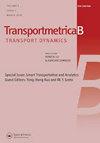A conservative expected travel time approach for traffic information dissemination under uncertainty
IF 3.4
2区 工程技术
Q2 TRANSPORTATION
引用次数: 3
Abstract
Travel time is important for both users and planners. Travel time variability widely exists in transportation systems. Positive skew with a long/fat upper tail is a basic characteristic of travel time variability, which poses great challenges to reporting travel time information to the public. There are two main approaches for disseminating travel time variability information: the traditional expected value and the percentile-based value. They are either unreliable when facing highly-skewed travel time variability, difficult to understand, or sensitive to individual risk preference. Motivated by this observation, this paper develops a conservative expected travel time (CET) approach to enhance the information reliability and maintain simplicity, which is formulated as a two-stage problem: (1) reshaping the travel time distribution, and (2) minimizing the expected value of the reshaped distribution. The features of the CET and the relationship between the CET and traditional measures are explored in both theoretical and numerical dimensions.不确定条件下交通信息传播的保守期望旅行时间方法
本文章由计算机程序翻译,如有差异,请以英文原文为准。
求助全文
约1分钟内获得全文
求助全文
来源期刊

Transportmetrica B-Transport Dynamics
TRANSPORTATION SCIENCE & TECHNOLOGY-
CiteScore
5.00
自引率
21.40%
发文量
53
期刊介绍:
Transportmetrica B is an international journal that aims to bring together contributions of advanced research in understanding and practical experience in handling the dynamic aspects of transport systems and behavior, and hence the sub-title is set as “Transport Dynamics”.
Transport dynamics can be considered from various scales and scopes ranging from dynamics in traffic flow, travel behavior (e.g. learning process), logistics, transport policy, to traffic control. Thus, the journal welcomes research papers that address transport dynamics from a broad perspective, ranging from theoretical studies to empirical analysis of transport systems or behavior based on actual data.
The scope of Transportmetrica B includes, but is not limited to, the following: dynamic traffic assignment, dynamic transit assignment, dynamic activity-based modeling, applications of system dynamics in transport planning, logistics planning and optimization, traffic flow analysis, dynamic programming in transport modeling and optimization, traffic control, land-use and transport dynamics, day-to-day learning process (model and behavioral studies), time-series analysis of transport data and demand, traffic emission modeling, time-dependent transport policy analysis, transportation network reliability and vulnerability, simulation of traffic system and travel behavior, longitudinal analysis of traveler behavior, etc.
 求助内容:
求助内容: 应助结果提醒方式:
应助结果提醒方式:


